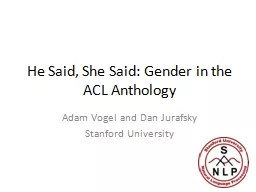

Adam Vogel and Dan Jurafsky Stanford University Gender in Computational Linguistics Well known gender imbalance in computer science In 2008 women granted 205 of PhDs CRA 2008 Linguistics departments are close to parity ID: 542042
Download Presentation The PPT/PDF document "He Said, She Said: Gender in the ACL Ant..." is the property of its rightful owner. Permission is granted to download and print the materials on this web site for personal, non-commercial use only, and to display it on your personal computer provided you do not modify the materials and that you retain all copyright notices contained in the materials. By downloading content from our website, you accept the terms of this agreement.
Slide1
He Said, She Said: Gender in the ACL Anthology
Adam Vogel and Dan JurafskyStanford UniversitySlide2
Gender in Computational Linguistics
Well known gender imbalance in computer scienceIn 2008, women granted 20.5% of PhDs [CRA, 2008]
Linguistics departments are close to parity
In 2007, women granted 57% of PhDs [LSA, 2008]
What about computational linguistics?Slide3
Gender Studies Methodologies
Previous studies utilize:University enrollment/graduation
Job placement
Professional society membershipSlide4
Gender Studies Methodologies
Previous studies utilize:University enrollment/graduation
Job placement
Professional society membership
Corpus based approach using publications:
Overall population
Publication counts
Authorship order
Topic models by genderSlide5
ACL Anthology Network
13,000 papers12,000 authorsNot
marked for gender
1965 – 2008
We only use data from 1980 onwards
[
Radev
et al, 2009]Slide6
Determining Gender by Name
Broad background of ACL authors makes automatic assignment difficult “Jan” in Europe vs. US
“
Weiwei
” in Chinese
Some names are poorly formatted or missing first names
H. Murakami
ukasz
The LOLITA GroupSlide7
Determining Gender by Name
Automatic approaches:Unambiguous first names from US census data
Morphological markings in Czech and Bulgarian
Lists of unambiguous Indian and Basque names
Hand labels:
Help from ACL authors in China, Taiwan, and Singapore
Personal knowledge or website photos
Remaining: 2048 names
Baby name website: www.gpeters.com/names/
Unknown: 761 namesSlide8
Female: 3359 Male: 8573 Unknown: 761
(26.7%) (67.5%) (6.0%)Slide9Slide10Slide11
Population Conclusions
Female authorship increased from 13% in 1980 to 27% in 2007Using best fit lines: 19.4% -> 29.1%
50% relative increase!
Male authorship decreased from 79% to 71%Slide12
Population Conclusions
Female authorship increased from 13% in 1980 to 27% in 2007Using best fit lines: 19.4% -> 29.1%
50% relative increase!
Male authorship decreased from 79% to 71%
Next: how prolific are men and women?Slide13
For 1st authored papers: Female 27% Male: 71% Unknown: 2%Slide14Slide15Slide16Slide17
Publication Count Conclusions
The most prolific authors are maleMen have on average been in the field longerMen and women have comparable publication output per yearSlide18
Publication Count Conclusions
The most prolific authors are maleMen have on average been in the field longerMen and women have comparable publication output per year
Next: what do men and women write about?Slide19
Latent Dirichlet
Allocation (LDA)Slide20
Generate 100 topics using LDA
Throw out 27 junk topics, yielding 73 substantive topics
Label topics based on their term distributions
Find
topics with biggest difference between men and women:
LDA for AANSlide21
Topic Calculations
Probability of a topic for a gender
Documents with 1
st
author gender gSlide22
Topic Calculations
Probability of a topic for a gender and year
Documents with 1
st
author gender g written in year ySlide23
speaker utterance act hearer belief proposition acts beliefs focus evidence
Sandra
CarberrySlide24
prosodic pitch boundary accent prosody boundaries cues repairs speaker phrases
Mari
OstendorfSlide25
question answer questions answers answering opinion sentiment negative
trec
positive
Soo
-Min KimSlide26
dialogue
utterance utterances spoken
dialog
dialogues
act
turn
interaction conversation
Diane
LitmanSlide27
class classes
verbs
paraphrases
classification
subcategorization
paraphrase frames acquisition
Anna
KorhonenSlide28
topic
summarization summary document news
summaries
documents
topics
articles content
Ani
NenkovaSlide29
resolution pronoun anaphora antecedent pronouns
coreference anaphoric definite reference
Renata
VieiraSlide30
students student reading course computer tutoring teaching writing essay native
Jill BursteinSlide31
Topic Conclusions
Women published relatively more papers in:Speech Acts + BDI
Prosody
QA + Sentiment Analysis
Dialog
Acquisition of Verb
Subcategorization
Summarization
Anaphora Resolution
Tutoring SystemsSlide32
dependency dependencies head
czech depen dependent
treebank
structures
Joakim
NivreSlide33
search length size space cost algorithms large complexity pruning
efficient
Kenneth ChurchSlide34
proof logic
definition let formula theorem every defined
categorial
axioms
Mark
HeppleSlide35
grammars parse chart context-free edge edges production symbols symbol
cfg
Mark-Jan
NederhofSlide36
label conditional sequence random labels discriminative inference
crf fields
Ryan McDonaldSlide37
unification
constraints structures value hpsg default head grammars values
James
KilburySlide38
probability probabilities distribution probabilistic estimation estimate entropy
Mark JohnsonSlide39
semantics logical scope interpretation logic meaning representation predicate
Jerry HobbsSlide40
Topic Conclusions
Men published relatively more papers in:Categorial
Grammar
Dependency Parsing
Algorithmic Efficiency
Parsing
Discriminative Sequence Models
Unification Based Grammars
Probability Theory
Formal Computation SemanticsSlide41
Conclusion
Approximately 50% increase in the proportion of female authors since 1980Men and women have similar publication rates
Gender labels for names available for download:
http://nlp.stanford.edu/projects/gender.shtmlSlide42
Acknowledgements
Thanks to Chu-Ren Huang, Olivia
Kwong
,
Heeyoung
Lee,
Hwee
Tou
Ng, and Nigel Ward for helping to label names for gender
Thanks to Chris Manning for helping to assign topic names
Thanks to Steven
Bethard
and David Hall for creating the topic modelsSlide43